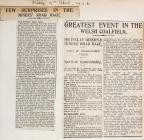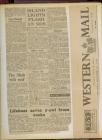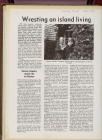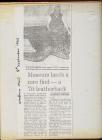Content can be downloaded for non-commercial purposes, such as for personal use or in educational resources.
For commercial purposes please contact the copyright holder directly.
Read more about the The Creative Archive Licence.
Description
There were times during the Great War, when the weather took its toll on vessels defending our waters against the submarine menace. The loss of two Scottish fishing vessels on 27 December 1915, was one such tragedy which touched communities in both Wales and Scotland. The Scottish fishing vessels, LADYSMITH and FERNDALE, had been hired by the Admiralty and put to use as armed patrol vessels/minesweepers. Sea mines or contact mines comprised a cylindrical drums containing explosives attached to a wire cable or sinker which could be adjusted to any length so that the mine would float just below the surface of the water. Fixed to the outside of the mine were horns connected to the exploding mechanism. As soon as a passing vessel touched one of the horns, the mine exploded. Sea mines were deployed in vast numbers within inshore waters. The very basic method of tackling the menace was to employ two vessels steaming side by side a short distance apart, dragging between them a length of cable which was fitted with a steel cutter. After snagging the mine, the cable would cut through the mine's wire sinker, the mine would then float to the surface where the crew would explode it harmlessly by rifle fire. It appears that the LADYSMITH was also tasked with deploying the steel anti-submarine nets at the entrance of Milford Haven. Net laying could be equally dangerous work. The FERNDALE began its life as steam drifter in 1910, being built at Lossiemouth on the north Aberdeenshire coast for local fishermen James Garden, John Allen Garden and J Mitchell. The LADYSMITH was another steam drifter, this time built at Banff, just a little to the east along the same coast, in 1904. This drifter had close associations to the fishing community of Portlockie, on the Moray Firth, Scotland. Both were caught in a tremendous gale, with gusts of wind reportedly reaching 90mph. It would seem that the skippers of both fishing vessels had determined to run for the shelter of the Haven, but in attempting the heavy seas breaking at the entrance between St Ann's Head and the Rows Rocks, both came to grief. A crewman was washed overboard from the FERNDALE, and as the vessel stopped to attempt a rescue, it was driven onto the rocks off St Ann's Head. The rocket apparatus was used in an attempt to get a line on board in order to rig a breeches buoy, but the wind was so strong it proved impossible. The naval officer and all 8 crewmembers were drowned, including James Garden, his brother and nephew. What happened to the LADYSMITH is still uncertain, but two more Scottish fishing families were devastated when it was also lost. The reporting in Fishing News shown in the image gives a true sense of the impact. Just before the Great War, the British fishing fleet was vast. As early as 1908, the Admiralty had begun developing plans to 'call up' men to man the trawlers it had ordered to help counter the increasing menace of sea-mines. These plans included requisitioning commercial vessels should the need arise. Some 150 vessels were thought to be all the Admiralty would need to complete its Royal Naval Patrol Service. However, by the end of the war, over 1,800 had requisitioned and the thousands of the fishermen who formed the core of their normal crews had been employed in theatres of war all around the world. A very special thanks to the editorial team of Fishing News and staff at Grimsby National Heritage Fishing Centre and Scottish Fisheries Museums who have helped untangle the identities of these two drifters.






Do you have information to add to this item? Please leave a comment
Comments (0)
You must be logged in to leave a comment